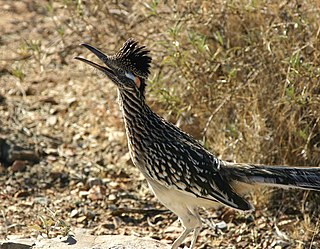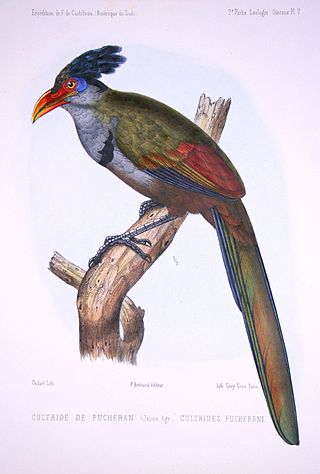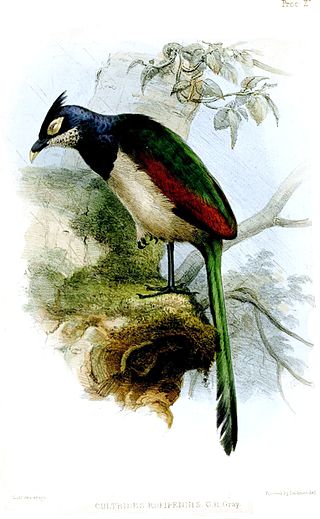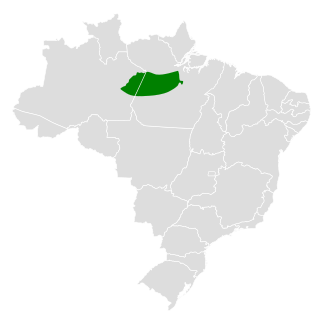
Cuckoos are birds in the Cuculidae family, the sole taxon in the order Cuculiformes. The cuckoo family includes the common or European cuckoo, roadrunners, koels, malkohas, couas, coucals, and anis. The coucals and anis are sometimes separated as distinct families, the Centropodidae and Crotophagidae, respectively. The cuckoo order Cuculiformes is one of three that make up the Otidimorphae, the other two being the turacos and the bustards. The family Cuculidae contains 150 species, which are divided into 33 genera.

The lesser roadrunner is a large, long-legged bird that is a member of the cuckoo family, Cuculidae. It is found in Mesoamerica. Its Latin name means "swift earth-cuckoo". Along with the greater roadrunner, it is one of two species in the genus Geococcyx.

The roadrunners, also known as chaparral birds or chaparral cocks, are two species of fast-running ground cuckoos with long tails and crests. They are found in the southwestern and south-central United States, Mexico and Central America, usually in the desert. Although capable of flight, roadrunners generally run away from predators. On the ground, some have been measured at 32 km/h (20 mph).

The striped cuckoo is a near-passerine bird, the only member of the genus Tapera. This resident cuckoo is found from Mexico and Trinidad south to Bolivia and Argentina and Colombia.

The Neomorphinae are a subfamily of the cuckoo family, Cuculidae. Members of this subfamily are known as New World ground cuckoos, since most are largely terrestrial and native to the Americas. Only Dromococcyx and Tapera are more arboreal, and these are also the only brood parasitic cuckoos in the Americas, while the remaining all build their own nests.

The pavonine cuckoo is a Neotropical cuckoo with a long graduated tail and a short crest. It is one of three species of Neotropical cuckoo which are known to be brood parasites.

The pheasant cuckoo is a species of neotropical cuckoo in the subfamily Neomorphinae of the family Cuculidae. It is native to Central and South America where it occurs in lowland tropical forest.

The rufous-vented ground cuckoo is a Vulnerable species of cuckoo in the tribe Neomorphini of subfamily Crotophaginae. It is found in Bolivia, Brazil, Colombia, Costa Rica, Ecuador, Nicaragua, Panama, and Peru.

Neomorphus is a genus of terrestrial cuckoos in the family Cuculidae. Despite their relatively large size, they are highly inconspicuous and rarely seen. They are restricted to the humid primary forests in the Neotropics, and despite their similar looks, not closely related to the Asian ground cuckoos of the genus Carpococcyx.

The red-billed ground cuckoo is a species of cuckoo in the tribe Neomorphini of subfamily Crotophaginae. It is found in Brazil, Colombia, Peru, and possibly Ecuador.

The banded ground cuckoo is an endangered species of cuckoo in the tribe Neomorphini of subfamily Crotophaginae. It is found in Colombia and Ecuador.

The rufous-winged ground cuckoo is a species of cuckoo in the tribe Neomorphini of subfamily Crotophaginae. It is found in Brazil, Guyana, Venezuela, and possibly Colombia.

The scaled ground cuckoo is a species of cuckoo in the tribe Neomorphini of subfamily Crotophaginae. It is endemic to the Amazon rainforest near the Tapajos River in Brazil.

The greater roadrunner is a long-legged bird in the cuckoo family, Cuculidae, from the Aridoamerica region in the Southwestern United States and Mexico. The scientific name means "Californian earth-cuckoo". Along with the lesser roadrunner, it is one of two species in the genus Geococcyx. This roadrunner is also known as the chaparral cock, ground cuckoo, and snake killer.
G. californianus may refer to:












